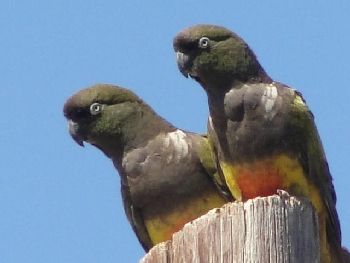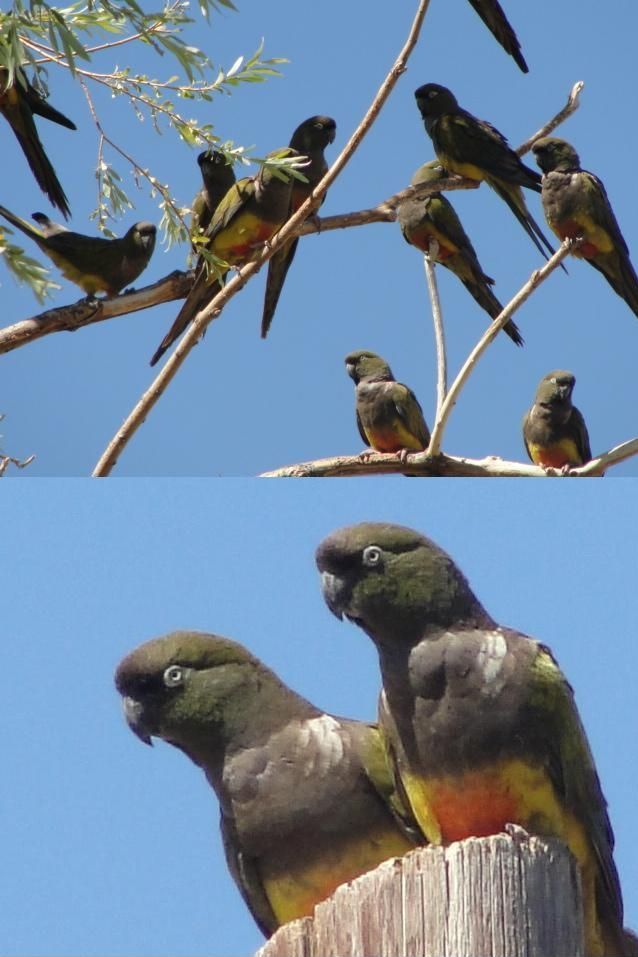
Publisher:
Bonnie King
CONTACT:
Newsroom@Salem-news.com
Advertising:
Adsales@Salem-news.com

~Truth~
~Justice~
~Peace~
TJP
Dec-29-2009 15:40

 TweetFollow @OregonNews
TweetFollow @OregonNews
Bird of the Week: Burrowing Parrot, Loro Barranquero, Cyanoliceus Patagonus
Gail Parker for Salem-News.comThe loro barraquero nests in dens or cliffs over the sea coast or along rivers, hatching up to four white eggs.
 Photos: Gail Parker |
(PATAGONIA, Argentina) - We have long been familiar with the local parrot, the cachana or austral parakeet which flies in groups around El Bolson - but were thrilled to see the largest of Argentine parrots, the burrowing parrot when we were recently in Chubut, to the south of Rio Negro Province.
This loro has a black beak, white-rimmed eyes, and an olive green head. The back and sides of the neck are whitish, the breast and back of the neck are greyish- olive, the flanks yellow-olive, the abdomen and upper legs are yellow and orange, the back is green/olive, the sides greyish, the wings olive with blue margins, an the legs and feet are whitish.
This large bird measures 460 mm, or over 18 inches.
The young are very similar to the mature birds, but somewhat duller in color and the white collar is less noticeable.
They are common and abundant in arid and semi-arid countryside, the steppes and the brushland. They are seen flying low in groups around the farmlands. They nest and brood in large common nests and rest on the branches of the trees or on the cliffs during the night. They can be heard screaming the whole night through.
At the break of dawn they fly, sometimes great distances, always in groups but not numerous. They eat seeds, grains, fruits and shoots found in areas where fruit trees are grown.
After eating they regroup in another place to rest, flying low in loud groups, they arrive one after another from different directions.
The loro barraquero nests in dens or cliffs over the sea coast or along rivers, hatching up to four white eggs. In the autumn the populations of the southern migrations go north but a part are permanent all year round. When they return in the spring, they fly in the mountains where they find abundant food to prepare for the long flight to the south, which is at a high altitude.
The distribution is from Neuquen and Rio Negro and the north of Santa Cruz in Patagonia, as far north as Salta, and east to Cordoba, La Pampa and Buenos Aires. There are various subspecies seen.
We encountered these birds in Gaimon, near the coast, perching together along the roadside in trees and on telephone poles. Ors laughed as I rushed out to photograph them and gave me kudos for a decent photograph.
Gracias a Ors y Carlos por todo de la informacion; es de su libro, Manual ilustrado de las Aves de la Patagonia, y errores son mios. (Thanks Ors and Carlos for all the info; it's from your book: The Illustrated Manual of the Birds of Patagonia, and any errors are mine.)

=============================================
 Gail Parker is a writer and photographer who lives in Argentina. She and her lifetime mate and husband Eddie Zawaski, who also writes for Salem-News.com, are former resident of Oregon, Gail has a great eye for memorable photos in this lush place called Patagonia. Her observations from this amazing wonderland of nature are a fun and welcome addition to our story flow.
Gail Parker is a writer and photographer who lives in Argentina. She and her lifetime mate and husband Eddie Zawaski, who also writes for Salem-News.com, are former resident of Oregon, Gail has a great eye for memorable photos in this lush place called Patagonia. Her observations from this amazing wonderland of nature are a fun and welcome addition to our story flow.
Watch for Gail's wonderful coverage of the birds of Patagonia in future stories and photojournals here on Salem-News.com.
Articles for December 28, 2009 | Articles for December 29, 2009 | Articles for December 30, 2009


Quick Links
DINING
Willamette UniversityGoudy Commons Cafe
Dine on the Queen
Willamette Queen Sternwheeler
MUST SEE SALEM
Oregon Capitol ToursCapitol History Gateway
Willamette River Ride
Willamette Queen Sternwheeler
Historic Home Tours:
Deepwood Museum
The Bush House
Gaiety Hollow Garden
AUCTIONS - APPRAISALS
Auction Masters & AppraisalsCONSTRUCTION SERVICES
Roofing and ContractingSheridan, Ore.
ONLINE SHOPPING
Special Occasion DressesAdvertise with Salem-News
Contact:AdSales@Salem-News.com
googlec507860f6901db00.html

Salem-News.com:
Terms of Service | Privacy Policy
All comments and messages are approved by people and self promotional links or unacceptable comments are denied.
gp December 31, 2009 3:40 pm (Pacific time)
oops! a couple of errors slipped by...first, I mistranslated the word montes which does not mean mountains, but instead brushland. So these birds don't fly in the mountains that I know of. Secondly, and more importantly, it is Cyanoliceus patagonus, a misspelling that is enough to really embarrass me.
[Return to Top]©2025 Salem-News.com. All opinions expressed in this article are those of the author and do not necessarily reflect those of Salem-News.com.